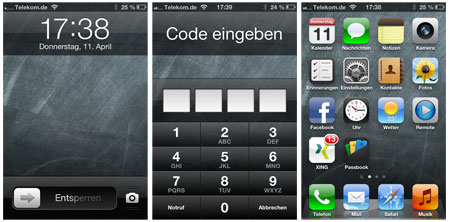Is the mouse an endangered species? Are iPads and iPhones making their users computer illiterate because they now only use things that they can operate with their thumbs? And is this good or bad news for Business Intelligence? That depends on how consequent people are.
In Berlin, we will soon be talking about “Emotional Management Information” (in German) – partially because all our efforts in collecting, saving, preparing, and presenting data in Business Intelligence are useless if the data has no effect. To generate an effect, we need to reach our recipients’ hearts as well as their brains. After all, we use emotions to help evaluate things and decide how we should invest the scarce resource of time every second of the day. iPhones and iPads emotionally charge reports because these media have so many fans. To ensure that the reports can live up to people’s expectations for these devices, however, we have to invent the right format – and for Business Intelligence that gets a bit complicated.

Touch gestures bring us back to the beginnings of evolution when the first tools were being developed. If we approach things too naively, we could also fall back to a primitive stage in the evolution of Business Intelligence as well.
The emotional effect of data has something to do with being responsible for it. In other words, what happens when the data presents good or bad news to the reader? How data is presented can determine if the recipient ever even reads it. The fundamentals for presenting data are changing dramatically – and so is the danger that the very last stretch in Business Intelligence will determine if all the efforts spent on collecting, saving, preparing, and presenting data have been wasted. These are the reasons:
- The mouse is an endangered species – The Facebook generation and, therefore, future BI users are growing up using touch gestures on mobile devices. People like you and me still have considerable experience with a mouse. We know all about right clicks, context menus, and tooltips. Others can confidently offer us great amounts of functionality in places where we would expect it – pixel-accurate but hidden. That, however, probably will not apply to future generations of computer users.
- Touch gestures are a problem, not a solution – Since iPhones and iPads have simplified a few common interactions with computers, many people now (mistakenly) expect that all of them should be that easy. But touch gestures, per se, are not simple. It is a Major achievement in design if you can easily operate something with a finger. Many poor-quality apps show that touch gestures are more of a challenge than a solution. Even a few common apps from Apple don’t have anywhere near the elegance that the unlock screen has. You could think that Steve Jobs himself oversaw the design of the iPhone’s gateway. If you dig a bit deeper in the operating system or even in apps such as iPhoto or Numbers, you’ll see a different story – and exactly where the developers had a harder time working around these restrictions. That, however, doesn’t make Apple’s mobile operating system iOS any less magical because the majority of users simply don’t use most of the irritating features. In Business Intelligence, however, we can’t just sit back and be content with magic: We can only reach our audiences if BI on iOS has the same sleek handling as the good parts of iPhones and iPads.
- Swiping is not interactive – For a long time, having information at your fingertips was the vision for management information. That primarily meant, however, the users could flexibly query and work with their data. Both concepts don’t work well on an iPad – and are even worse on an iPhone. Upon taking a closer look, we see that our beloved devices quickly become an obstacle as soon as the task at hand involves more than swiping a finger to leaf through pages and rolling with your thumb to make selections. Since you can place your finger anywhere on the screen, it is even easier to turn pages on an iPad – at least to the very next page – than in a book. Time and time again, the “user experience” on an iPhone or iPad lives from surprising factors like these: less human action, more machine-made and matching reaction. The problem for Business Intelligence, however, is that if people continue to swipe, they still need to be allowed to think further – in other words, to forget the topic that they just viewed and go on to the next one. Office computer screens are getting bigger and bigger. Since you can place several pages next to each other on these screens, needing more than one page for a given topic is no longer an issue. That also means, in turn, that not everything that works on an office computer will automatically work on mobile devices – even when the interaction is limited to swiping. The work involved in designing the same content for different media can be a major challenge for BI teams. The iPhone, for example, is especially challenging. The only reports that are really suitable for this device are those that you can break down into tidbits of information so that when you scroll through them with your thumb, they make as much sense as a weather app. That type of format, however, has nothing to do with one that you would use on a computer screen. One exception would be reports that highly involved readers know by heart. If they know the same format but larger (e.g. from their PC) and already know where to look, they could manage using pinching gestures to zoom in and out. But that is always the case: If people know reports very well and find their content highly interesting, they would always make the extra effort – no matter how complicated things may get.
- Form follows function. Function follows content. – In our own company, we are experimenting with new iPad report formats that offer interactive functionality within an intelligent, predefined framework. What makes them attractive is that the data, recipients, situation (i.e. mobile), task, and handling paradigm are perfectly woven together in the application. In order to do that, we need to permeate the respective task from a business view down to the smallest detail. The source of our inspiration is the passionately, consequently designed sequence of the iPhone welcome screen. (This comparison might surprise you until you see how miserably other global companies fail at such a task.) For BI, each interaction with the data must lead to exactly the variation of content and form that the user intuitively expects. When you swipe to unlock your iPhone, the next display asks you to enter your code – what else would you expect? If this “what else” feeling occurs while someone is tapping and swiping reports on an iPad, it is a success – but not beforehand. This type of report design can only work when it is developed wholeheartedly and in close cooperation with actual users. That again shows what type of challenges finger gestures ultimately pose to the Business Intelligence community. Transferring the achieved status of a non-mobile environment to a mobile one is so much more than simply moving from one media to another.

Swipe once, see it slide, type four times, and it is ready to use. In the iPhone’s operating system, you truly feel how nice touch navigations can be. In most apps, however, you also sense where its limitations are.

A light effect focuses your attention on the unlock key and shows the correct direction of the swiping movement.

In place of the current time, you now see “Enter code”. The numeric keypad drives into sight and the fourth number dually functions as return key.
With this in mind, Business Intelligence could be faced with a task that is indeed hard to solve. In many companies, non-mobile reports have yet to develop their desired effect. Now, these same applications are supposed to go mobile with interaction paradigms that are 1.) not fully understood in BI, 2.) possibly on multiple platforms, and 3.) not native, in other words, with not-so-elegant handling. Based on our assessments, the productivity of BI applications will first drop before solutions are found that actually benefit from finger gestures. We perceive both the pressure towards simplification and the necessity to focus much more deeply on the business tasks of users as being positive. That is sobering to some degree – but that’s okay because we need to be levelheaded in order to trigger the appropriate emotions from the recipients of our reports through a cool, calculated design. You’ll hear more about our suggestions soon in Berlin (in German).
